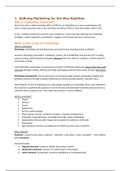Summary
Samenvatting Marketing Management - Kotler Keller
- Module
- Institution
- Book
H1 tot 22. Kottler Keller. Marketing Management. 15th edition. Pearson. Useful for the study Business and Consumer Sciences at Wageningen University. Also including images to better understand the theory!
[Show more]













